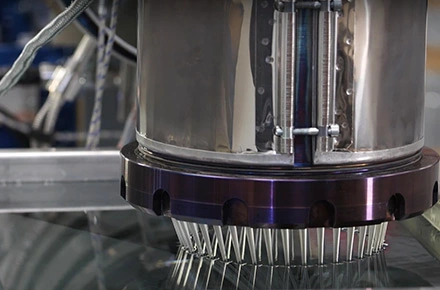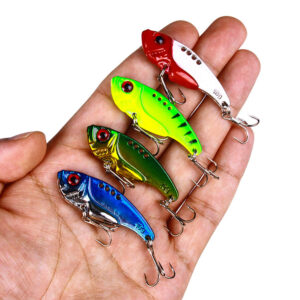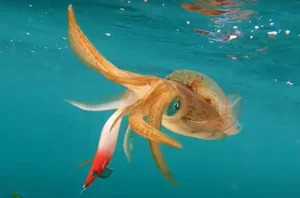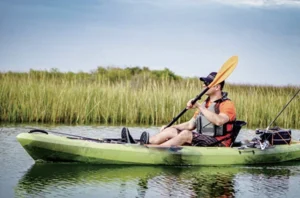Fishing is fun and rewarding. Choosing the right fishing line is important when targeting different types of fish.
There are different types of fishing lines for various needs. Light and flexible lines are great for panfish. Heavy-duty lines are ideal for big-game fish.
Knowing which line to use is key for a successful catch. Let’s explore the best fishing line types for different fish species to help you catch that big one!
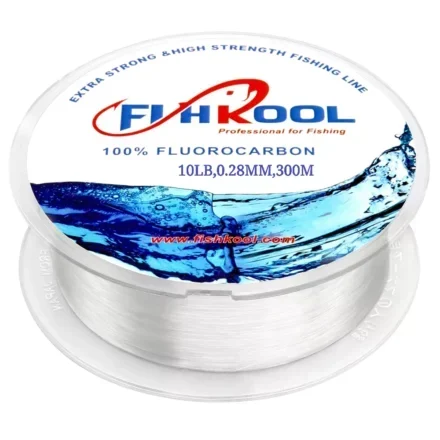
Best Fishing Line Types for Different Fish
Freshwater Fishing:
- Beginners often use the mono fishing line because it is forgiving and has stretch.
- Mono is good for setting the hook on bass in shallow waters.
Saltwater Fishing:
- Fluorocarbon fishing line is popular for saltwater fishing.
- It has abrasion resistance and lower visibility in clear water.
Big Game Fishing:
- A braided fishing line is favored for big game fishing.
- It is strong and has shock strength for battling larger species.
Additional Tips:
- Anglers pair mono or fluorocarbon leaders with braided lines for extra strength.
- Choosing the right fishing line type depends on the targeted species. It also depends on the fishing conditions and the angler’s skill and preference.
- Choosing the right fishing line is important for a successful day on the water. This is true whether casting, trolling, or spinning.
Monofilament Line vs. Braided Line
Pros and Cons of Monofilament Line
Monofilament fishing line has benefits for anglers.
It’s flexible and forgiving when tying knots or casting, ideal for beginners.
Fish can see these lines less because they are clear. This makes it easier to catch fish.
They also have shock strength. This makes them useful for various fishing styles, like trolling or spinning.
However, compared to braided or fluorocarbon lines, mono lines have drawbacks.
They have more stretch, affecting casting precision and jigging.
They also have more memory, leading to tangles that can affect the fishing experience.
Still, despite these downsides, anglers prefer monofilament lines. They like them for their versatility and ease of use in different fishing scenarios.
Advantages of Monofilament Line
Monofilament line has many advantages over other types of fishing lines. It has good shock strength and flex. This makes it great for varied fishing conditions.
It’s known for its ability to stretch. This can help when targeting species with aggressive strikes. Mono lines also have low memory, so they lay flat on the reel and sink easily, making them popular among anglers.
Monofilament lines perform well in casting distance and sensitivity. They give anglers the precision needed to present baits well.
Considerations for Monofilament Line
When choosing monofilament line for fishing, consider these factors:
- Diameter affects visibility in water
- Thinner lines are less noticeable to fish
- Strength is important for landing big fish without breakage
- Stretch can help absorb shock when trolling or spinning
- Memory can lead to coils and tangles, affecting casting and knot-tying
Compared to braided or fluorocarbon lines:
- Monofilament may have less sensitivity and abrasion resistance
- Consider line color based on water clarity and target fish species
- Clear lines are good in light conditions. Red lines are for deep or low-light situations.
Both beginners and pros need to know the pros and cons of the monofilament line. It’s key for catching more fish in different scenarios.
Pros and Cons of Braided Line
The braided line is strong and sensitive. It is great for fishing in heavy cover or deep water where accuracy matters.
It stretches very little. This allows for better hook sets and more sensitivity. You can detect even the lightest bites.
However, the lack of stretch can lead to more pulled hooks and higher visibility in clear water.
A braided line is better than monofilament or fluorocarbon lines at resisting abrasion. It also casts farther.
In some cases, using a leader with a braided line may be necessary.
Anglers should consider the fish species, bait type, and fishing conditions. They should do this when choosing between braided lines and other options.
You must understand the strengths and weaknesses of a braided line. This is important when fishing for bass or deep-sea species.
Advantages of Braided Line
The braided line offers advantages over monofilament and fluorocarbon fishing lines.
- It has a thin diameter. This improves casting lighter baits. It also helps in fishing deep waters because of its high strength-to-weight ratio.
- Anglers can feel even the slightest nibbles because it has a low stretch. This leads to more precise hook sets when using jigs or lures.
- The braided line lacks memory. This stops tangling and bird nests in spinning reels, so beginners like it.
- Its high shock strength is great for heavy-cover fishing. This includes bass fishing in dense plants.
- The visibility of the braided line can be helpful when trolling. It allows for better depth control.
- Use red braided lines in applications like jigging or trolling for different fish. It can attract more strikes.
Considerations for Braided Line
When choosing a braided line for fishing, anglers need to consider many key factors.
- Braided lines are strong and durable compared to monofilament or fluorocarbon lines.
- They offer more sensitivity and precision. This makes them great for detecting bites and setting hooks. They are great for jigging or lure fishing.
- Braided lines have minimal memory, reducing backlash when casting.
- Consider the color, visibility, shock strength, and abrasion resistance of the line. This is especially important in heavy cover or rocky areas.
- Different fish species may need different line weights. So, picking the right pound test is crucial.
- Understanding fishing conditions, target species, and best techniques are key. They help in selecting the best-braided line for a successful fishing trip.
https://fishkoolsports.com/product/pe-braided-line/
What Type of Fishing Line is Best for Freshwater Fishing?
Copolymer Line for Freshwater Fishing
When choosing a fishing line for freshwater fishing, a copolymer line is a great option. Here are some advantages:
- Copolymer lines have less memory, reducing tangles and providing smoother casts.
- They resist abrasion better than monofilament lines. This makes them suitable for rocky or vegetated areas.
- Copolymer lines are less visible underwater. This can help when trying to catch cautious fish.
When to Use Fluorocarbon Line in Freshwater Fishing
Using a fluorocarbon line can be helpful when fishing in clear freshwater conditions. It is nearly invisible underwater which is great for catching wary fish like bass. Fluorocarbon has less stretch than monofilament, providing better sensitivity for detecting bites. Its abrasion resistance is beneficial when fishing near rocks or structures. Fluorocarbon is denser. It sinks faster, so it’s good for targeting deep-dwelling species.
In situations, where precision casting or using small lures is necessary. Fluorocarbon’s low visibility can attract more bites. Applications such as trolling or spinning must shock strength. Fluorocarbon can handle sudden movements. It does not break. Many anglers prefer fluorocarbon. They like its strength, knot-holding abilities, and reliability in different fishing situations.
What Type of Fishing Line is Best for Saltwater Fishing?
Fluorocarbon Line for Saltwater Fishing
Anglers who want to trick fish in clear saltwater should use a fluorocarbon line. This type of line sinks fast, making it great for deep-sea fishing when accuracy is key.
When choosing fluorocarbon line for saltwater fishing, shock, abrasion, and knot strength are key. It’s almost invisible underwater. It’s better than mono or braided lines. It increases the chances of a good catch.
It has low stretch. It is highly sensitive. This makes it perfect for feeling subtle strikes. You use it when using live bait or jigging. These qualities suit the demands of saltwater fishing well. They provide a satisfying experience when targeting various species in different saltwater spots.
Braided Line for Saltwater Fishing
The braided line for saltwater fishing has many advantages.
- It has a strong strength-to-diameter ratio. This allows the use of lighter lines without losing strength.
- This is crucial when targeting larger fish that need more shock strength when caught.
- The braided line has low stretch. It offers better sensitivity for detecting subtle bites. This makes it great for jigging or casting.
- When choosing a braided line, consider factors like color, visibility, and abrasion resistance.
- Certain colors may be more visible to fish depending on water conditions.
- Abrasion resistance is important when fishing near structures like rocks or reefs.
- Braided line is versatile for saltwater fishing. It suits both beginners and experienced anglers.
- This fishing line provides precision casting and strong knot strength. It also sinks baits easily to the desired depth for successful fishing.
Fly Line for Fly Fishing Enthusiasts
Advantages of Using Fly Line
Fly Line is great for fly fishing enthusiasts. It’s better than monofilament, braid, or fluorocarbon lines. It helps with precise casting and bait/lure control.
The low stretch of the fly line is important for quick hook sets. This is crucial for catching fast or delicate fish.
Different colors of fly lines make them easy to see in different fishing conditions. They don’t tangle easily, which is helpful for beginners.
Some fly lines can sink, making it easier to catch fish at different depths. They are also strong enough to handle big fish.
The thin fly lines and the right knot help with smooth casting and jigging.
The fly line is versatile. It can improve fishing in many conditions.
Considerations for Fly Line
Considerations for fly lines in fishing are important.
When picking the best fishing line for fly fishing, the weight and taper are key. They matter for casting and presentation.
The weight of the line affects casting ability and accuracy in delivering bait or lure.
Various types of fly lines work for different conditions and species. These types include mono, monofilament, braid, fluorocarbon, copolymer, and braided lines.
For instance, mono lines are stretchy and visible. They are good for beginners. Fluorocarbon lines are clear and sink quickly, ideal for deep fishing.
Braid lines provide strength and less stretch, suitable for jigging or trolling baits.
Color, memory, knot strength, and shock strength are also key. They matter for successful fishing.
Choosing the right fly line is crucial. It should be based on fishing conditions, the target species, and personal preferences. It’s key for a successful day of fishing.
https://fishkoolsports.com/product/fly-line-weight-forward-taper/
Best Fishing Line Types for Big Game Fishing
Pros and Cons of Monofilament Line for Big Game Fishing
Using monofilament lines for big game fishing has its benefits and drawbacks.
The advantages of mono lines are:
- They can stretch, providing shock strength when battling large fish.
- They are beginner-friendly when tying knots.
- Thin, single-color lines are less visible in water. This can help in some fishing situations.
However, anglers should also consider the disadvantages:
- Mono lines have more stretch than braided lines, which may affect precision in tasks like jigging or trolling.
- Mono lines have more memory, which can lead to line twists and tangles.
- Monofilament lines are weaker than braided lines. This is especially true when dealing with strong fish.
Advantages of Monofilament Line for Big Game Fishing
The Monofilament line has several advantages for big game fishing. Its stretchability can absorb shocks when a large fish strikes. This reduces the risk of the line breaking. Monofilament has lower memory than braided lines. This results in smoother casting and fewer knots. The red color of this line makes it very visible in the water. It helps anglers track their lines and see when fish bite.
Additionally, monofilament lines sink, which helps fish deep-water species. When fishing near structures like rocks or reefs, mono’s abrasion resistance is handy. In trolling situations, the line’s stretch can prevent hooks from pulling out of a fish’s mouth.
Considerations for Monofilament Line for Big Game Fishing
When choosing a monofilament line for big game fishing, anglers should consider factors. These include strength, stretch, and abrasion resistance.
The diameter of the line is important. Thinner lines are harder for fish to see but might not be as strong.
The Monofilament line is good for casting and can handle sudden pulls. However, anglers should compare it to braided or fluorocarbon lines.
Red or clear monofilament lines are common for their visibility. But they might not hold their shape well sometimes.
Anglers should think about the fish they’re after and the bait they’re using.
In general, the monofilament line is a good choice for beginners. It’s forgiving, works in many situations, and costs less than other lines.
Conclusion
Different types of fish require different fishing lines to maximize success.
- Monofilament lines are versatile and great for beginners.
- Braided lines are strong and durable, perfect for larger fish.
- Fluorocarbon lines are virtually invisible underwater, making them ideal for finicky fish.
Consider the fish’s traits. Use this info to choose the right line for your next fishing trip.

